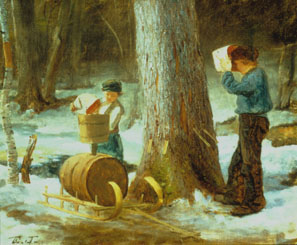
february 18–april 18, 2004
Making Maple Sugar
In the 1860s maple sugar was an important crop in northern New England and the major sweetener used by farm families. Sugar season began, as it does today, with the break in frigid weather in late winter signaled by daytime temperatures in the mid-forties and nights in the mid-twenties, the ideal conditions for a good sap flow. During this time the sap, a clear, colorless fluid, flows from a tapped hole between the bark and wood into buckets at a rate as high as two hundred drops of sap per minute or, colloquially, "two drops per heartbeat." The containers are then transported to the sugar camp, where the sap is boiled and farmers and villagers gather for the sugaring-off parties.
Johnson's paintings are accurate in their portrayal of maple sugaring, yet they are tinged with a deep nostalgia. Even at the time, the methods of making sugar he depicts were old fashioned, and his paintings not only celebrate the virtues of tradition but also acknowledge the challenges to tradition represented by advances in technology and the shift away from an agrarian economy.
The Sap Gatherers
c. 1861-66
Private collection, Glen Ridge, New Jersey)

